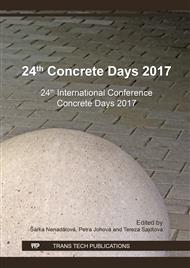p.88
p.94
p.102
p.107
p.115
p.121
p.127
p.135
p.141
Shear Resistance of Concrete Beams with FRP Grating as a Shear Reinforcement
Abstract:
This paper presents an experimental study on the shear behavior of concrete beams with fiber-reinforced (FRP) composite grating as shear reinforcement. Corrosion resistance and non-magnetic properties of FRP reinforcement allows its use in places where application of regular steel reinforcement would face difficulties. The use of FRP composites can increase the life span of constructions and reduce its maintenance costs. Shear stirrups are more susceptible to harsh conditions, due to their placement at the outer face of the reinforcement, and the use of FRP materials can lead to lower concrete cover thickness and therefore to a more effective design of an element. FRP reinforcements are highly anisotropic material with low strength in the direction perpendicular to the fibers. This causes the strength of a FRP stirrup to be limited by its strength in the bends (corners) of a stirrup. The tensile strength in the corner of the bent stirrup is around 40 to 60% of the strength of the straight bar. FRP grating doesn’t contain a bent section limiting its strength, but its behavior as a shear reinforcement is unknown. The paper contains the results of own experimental research on concrete beams with shear reinforcement made of FRP gratings done at the Faculty of Civil Engineering at the Brno University of Technology. Test specimen consisted of nine beams with different shear reinforcement ratios. Presented experimental data are then compared with the results of tests on beams with regular shear FRP stirrups found in literature.
Info:
Periodical:
Pages:
115-120
Citation:
Online since:
February 2018
Authors:
Keywords:
Price:
Сopyright:
© 2018 Trans Tech Publications Ltd. All Rights Reserved
Share:
Citation:


